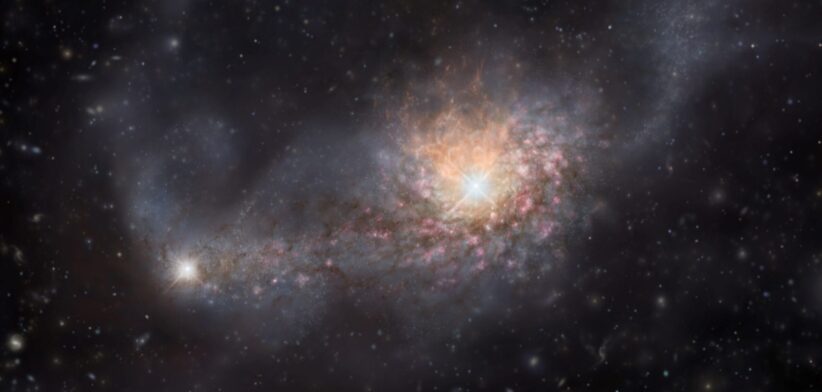Astronomers are watching two galaxies merge 12.8 billion years ago as they create one of the brightest objects in the Universe.
An international team of researchers are using the ALMA (Atacama Large Millimeter/submillimeter Array) radio telescope in northern Chile to study the earliest known pair of close quasars.
Lead researcher Takuma Izumi said their characteristics indicated that the merger would form a monster galaxy, one of the brightest types of objects in the Universe.
Professor Izumi said the results of the study were important for understanding the early evolution of galaxies and black holes in the early Universe.
He said quasars were bright objects powered by matter falling into a supermassive black hole at the centre of a galaxy.
“The most accepted theory is that when two gas-rich galaxies merge to form a single larger galaxy, the gravitational interaction of the two galaxies causes gas to fall towards the supermassive black hole in one or both of the galaxies, causing quasar activity.”
Professor Izumi said to test this theory the team focused on the earliest known pair of close quasars.
“Located in the direction of the constellation Virgo, this pair of quasars existed during the first 900 million years of the Universe.
“The pair is dim, indicating that the quasars are still in the early stages of their evolution.”
He said the ALMA observations mapped the host galaxies of the quasars and showed that the galaxies were linked by a “bridge” of gas and dust.
“This indicates that the two galaxies are in fact merging.”
Professor Izumi said the ALMA observations also allowed the team to measure the amount of gas, the material for new star formation.
“The team found that the two galaxies are very rich in gas, suggesting that in addition to more vigorous quasar activity in the future, the merger will also trigger a rapid increase in star formation, known as a “starburst”.
“The combination of starburst activity and vigorous quasar activity is expected to create a super-bright object in the early Universe known as a monster galaxy.”








